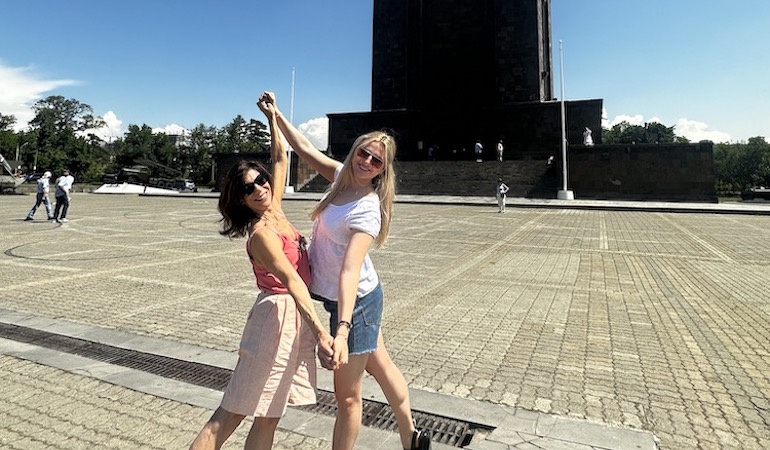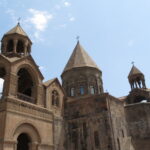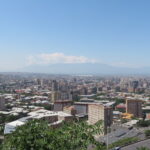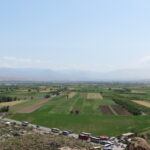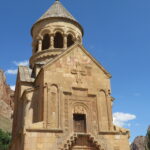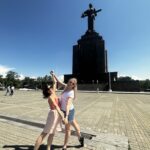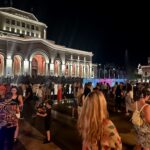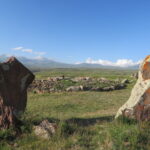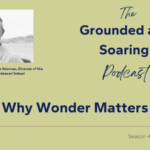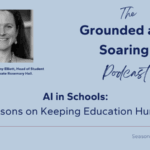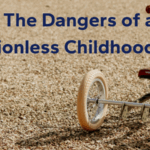At the heart of every story of migration lies a deeply personal narrative, one that links the past with the present, one that tries to make visible the history of identity and how it influences the future.
For Sophia Crane, a Marin Montessori School Junior High alumna from the class of 2017, this narrative became a journey—a literal and metaphorical return to her ancestral roots in Armenia, sparked by a project initiated during her time at MMS when she was 14 and that has continued into her adulthood.
Sometimes a class project isn’t a class project; it’s the spark that burns for a lifetime.
Re-Wind to Junior High
At MMS’ Junior High, students choose which of several course offerings they want to join. As an 8th grader, Sophia signed up for the U.S. Immigration Humanities class, which aimed to use personal immigration stories as a means of connection with a complex topic.
As the teacher of this class, I found that working at a school that provides meaningful professional development was key. The Story Center in Berkeley, California, offered a course on creating a short narrative video called a digital story, and trained educators on using the multi-user platform WeVideo.
Students each learned to research and build a family tree using Ancestry.com from a lesson by a teacher with both experience and a passion for genealogy, Andy Gaertner. He taught students to locate primary source documents and some students were able to find their family members’ signatures on the immigration document at Ellis Island or the immigration ship’s manifest.
Sophia dug into the details of her family’s immigration story as they traveled from Armenia to New York. Her great-grandmother fled the Armenian genocide and immigrated to New York. In the class, Sophia collected primary source documents and family images and wrote a narration of the story which she then used to create a short film. It was a story of people fleeing for their lives and also of building a new life in the United States.
For Sophia, the project allowed her to take a personal, emotional attachment to an academic one. She notes,
My mom introduced my brother and me to our Armenian heritage from the beginning of our childhood. We latched onto the cuisine and alphabet – Armenian food is similar to Mediterranean, Arabic, and Slavic cuisines… My mom told us stories all the time about learning to cook traditional dishes with my grandmother. We still have an Armenian-influenced Thanksgiving with Basturma, Dolma, and Baklava. I remember standing in my Auntie’s kitchen stringing the white braided cheese into fine threads to eat with lavash or pita.
The more she explored, the more Sophia expanded her understanding of her heritage – both its beauty and its tragedy:
The first time I really understood the term “Genocide” was in Minnie’s class. The Armenian Genocide took place during World War I. The Ottoman Empire killed over 1 million ethnic Armenians living in the Balkans, and forced those remaining to renounce their Christian beliefs and convert to Islam. Turkey refuses to acknowledge their actions against the Armenian people to this day.
The main takeaway I learned from Minnie’s class was gaining an understanding of history and how it directly relates to my life. This ancestry project has sparked an interest in pursuing and educating myself on current events. Building a sense of self-awareness of what came before me and what systems we are still settling into gives me context to living with intention and gratitude.
At the end of the class, all the films were saved to Google and sat in the cloud, which is why, all these years later, Sophia can return to the moment when the fuse of immigration curiosity was lit.
From Project to Pilgrimage
Today, Sophia is living and working in San Francisco. She is pursuing her dream of becoming a professional ballerina while also working as a pilates instructor at The Studio Marin in San Rafael and Equinox Fitness in San Francisco. Now in her early twenties, she is a dancer with Alonzo King LINES Training Program in San Francisco.
Years after her Junior High project, Sophia felt a genuine desire to explore her ancestry and personal immigration story further, which partly inspired her and her mother, Susan, to plan a trip to Armenia.
The decision was also influenced by Sophia’s aunt, Adrienne Krikorian, involved with Mer Hooys, an organization aiding disadvantaged Armenian girls. “My aunt organized the pilgrimage. It felt surreal, walking the land my great-grandparents once called home, experiencing the culture, and connecting with the resilient women of Mer Hooys.”
Arriving in Armenia, Sophia encountered a blend of familiarity and foreignness. “I felt out of place initially,” she admits, “but the warmth of the Armenian people and their eagerness to connect over shared heritage was overwhelming. It wasn’t about looking Armenian; it was about feeling Armenian.”
This pilgrimage was more than a return to her ancestral land; it was an exploration of identity and belonging. “I’ve always been described as headstrong, a trait I see mirrored in the Armenian spirit. This trip solidified my connection to my heritage, teaching me the importance of community and family over individual success,” Sophia reflects.
A Legacy of Resilience
Sophia’s return to Armenia allowed her to immerse herself in the traditions, language, and cuisine she had only known through stories. “Visiting the Genocide Museum and standing on Armenian soil made my family’s past palpable. It’s one thing to read about history, but another to live its consequences,” she states.
It felt surreal, walking the land my great-grandparents once called home.
Sophia’s journey back to Armenia was not just a return to a geographic location but a deeper exploration of identity, belonging, and the enduring impact of history on individual lives. The experience of being physically present in Armenia brought a new dimension to her understanding of her heritage. It was a realization of how the past shapes the present, how stories of survival and resilience resonate through generations, and how a sense of belonging can transcend geographic and cultural boundaries.
While in Armenia, Sophia saw that the work that she did to understand her family and herself as a teenager was still alive. Reading about fleeing from genocide is one thing, but the visceral nature of understanding that because of her ancestors fleeing, she is here today is another. Visiting the Genocide Museum in Armenia was yet another opportunity for her to further her understanding of her roots.
“I challenged myself to surrender to the experience,” she notes. “It was a good reminder for me to recognize that although career success is great, it means half as much if you don’t have a family and community to share that success and gratitude with.”
The trip to Armenia allowed Sophia to experience firsthand the traditions, language, and cuisine she had only known through her family’s stories. It deepened her connection to her Armenian heritage and provided a poignant perspective on the importance of understanding one’s roots. “[Before the trip,] I was tentative to claim my Armenian heritage because I don’t look like most Armenian women. Blood still counts, and my involvement in the culture, history, and community counts.”
The Montessori Influence
Sophia’s story is a testament to the power of education to ignite curiosity, foster a sense of identity, and encourage a lifelong journey of discovery. The Montessori approach, with its emphasis on student-led exploration and real-world connections, provided her with the tools to embark on this journey. It illustrates how education can extend beyond the classroom, influencing students’ lives in profound and lasting ways.
“The project that started in Minnie’s class ignited a flame that guided me to Armenia,” she explains, “helping me understand my identity and the resilience of my ancestors.” This educational approach encourages students to explore beyond textbooks, understanding history through personal narratives and firsthand experiences.
This exploration of identity and belonging is particularly relevant in today’s globalized world where questions of heritage and identity are increasingly complex. Sophia’s story serves as a reminder of the value of connecting with one’s roots and the rich tapestry of experiences that shape who we are.
As we navigate the complexities of the modern world, stories like Sophia’s remind us of the enduring power of understanding our past to inform our present and future.

Minnie McBride is one of the founding faculty members of Marin Montessori School’s Junior High. At the time, the student body was made up of just nine students. A third-generation teacher, Minnie studied environmental science at Oregon State University, earned her teaching credential from Dominican University of California, and recently completed her Master of Science in Education at Dominican as well.


